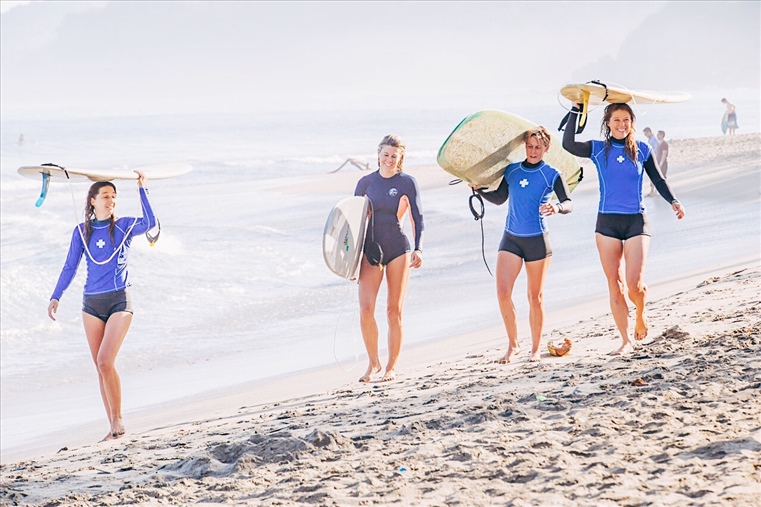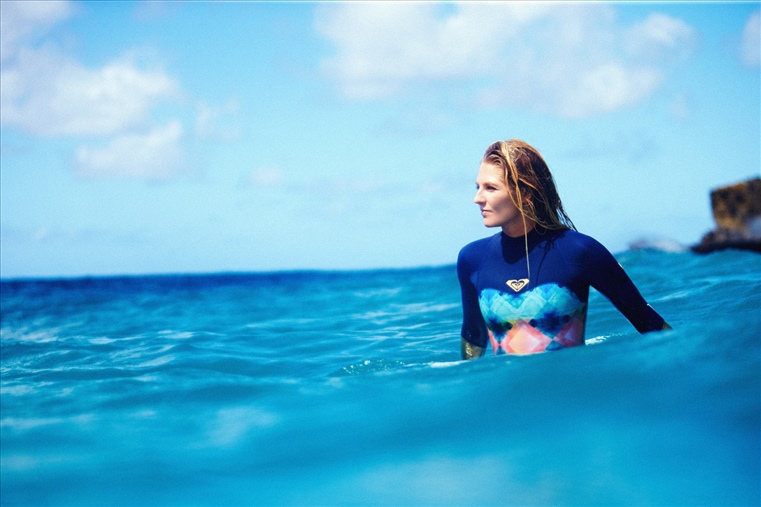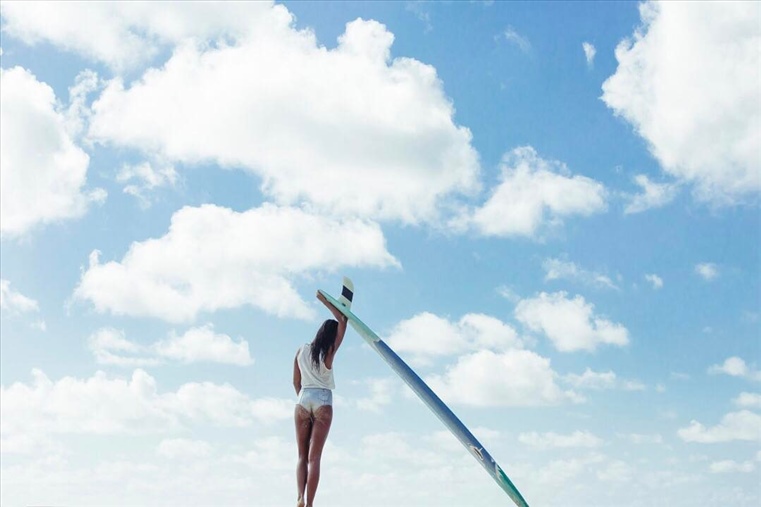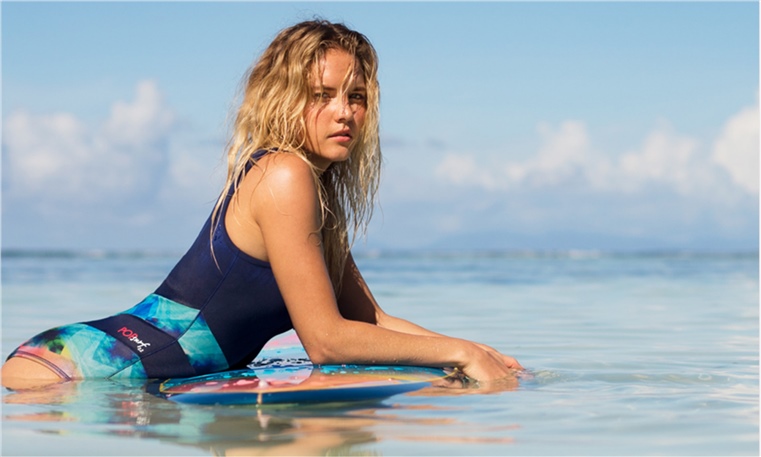How to Choose the Best Women's Spring Suit
April 05, 2017 | By
by Bev Sanders, founder of Las Olas Surf Safaris for Women

A frequent question from first-time surfers coming to a Las Olas surf and yoga retreat is, “What type of swimsuit should I bring?” Many ask if a light neoprene spring suit is necessary in the bathwater temperature beaches of Mexico. Even when the water is warm, a light spring suit makes me feel less vulnerable, and our surf coaches wear them under their rashguards for extra warmth and protection.
When it’s too chilly to wear a bikini alone but a full armed and legged wetsuit is overkill, a light neoprene wetsuit is essential in any surfer’s quiver. After twenty years surfing in the warm waters of Mexico and the chillier coasts of central California, I’ll do my best to guide you through the frequently asked questions when choosing your first spring suit.
What is a spring suit?
Spring suits come in several different silhouettes–– long sleeves and bikini-cut bottoms, sleeveless and mini-short bottoms, even trendy bikini separates––all made in neoprene thickness between 0.5mm to 3mm. The higher the millimeter thickness number, the warmer the suit will be.
Why do I need a spring suit?
Think of a spring suit as your light sweater in the water. Surfers, wakeboarders, kite surfers, and other watersport enthusiasts wear a spring suit during those times when wearing a swimsuit alone has them shivering after 30 minutes, but would sweat in a full bodied wetsuit. The spring suit offers that sweet spot in between.
These suits are perfect for sunny summer days in Southern California, or cooler seasons in Florida. The water temperatures (for example, 65-70 plus degrees) are below the feeling of tropical bathwater, yet a full wetsuit would be over the top—like wearing a down jacket on a sunny spring day. Even in tropical water like Hawaii, Mexico, Central America, or Bali, you’ll love having a spring suit when the tradewinds start blowing and make the air feel colder. Even a neoprene bikini or a sleeveless one-piece provides a little bit of extra warmth compared to swimsuit fabric alone.
We have underwater reefs to thank for creating beautifully shaped waves, but if the tide is low and the water level is shallow, those reefs can be treacherous if you wipe out. A spring suit’s neoprene shell may be thin, but it’s thick enough to offer protection from scrapes on the rocks. Snorkelers love spring suits because they provide extra warmth when swimming underwater for longer periods of time, as well as creating a layer of defense against jellyfish stings or other sea critters.
And don’t forget: a long-sleeved spring suit offers sun protection from harmful UV rays.

How do I choose a spring suit?
There are so many fun options nowadays –– prints, bold color-blocks, and classic black suits. Styles usually fall into these four categories, with endless variations within each type:
1. One piece with short legs. The arms on spring suits vary from sleeveless, short or long sleeves. The bottoms range from cheeky bikini cut, mini short, or mid-thigh length shorts. The different sleeve and bottom styles get mixed and matched together in countless ways for a dizzying number of options.
Best for: If you buy one spring suit, we recommend a 2mm long sleeved version with whichever bottom cut you're most comfortable in. Many surfers love this versatile style because the long sleeves provide arm and core warmth, as well as full sun protection. These cover water temperatures ranging from 65 - 75 degrees Farenheit.
If you surf in waters warmer than 75 degrees like Hawaii, mainland Mexico, Central America, or Bali, a sleeveless or short sleeve spring suit is your best bet. There are also fantastic options that resemble a one-piece bathing suit in neoprene fabric. Don’t forget to add a rashguard for extra sun protection, and avoid the hassle of slippery sunscreen arms!

2. Bikini. These exciting styles change based on the trends, but they commonly offer a fuller coverage top that provides good support and comfort for paddling. Bottoms range from bikini, mini shorts, and high waisted vintage-inspired cuts.
Best for: A light neoprene bikini is perfect if you want to have fun with your style, and surf in warm waters over 75 degrees. They don’t provide as much warmth and protection as one pieces, but they make up for it by being super versatile. You can mix and match them with a neoprene jacket or other separates.
3. Wetsuit jackets and separates. A zip-up wetsuit jacket is exactly as it sounds: an easy jacket to layer over a sleeveless spring suit or wetsuit.
Best for: A zip up or pullover neoprene jacket is a versatile piece of add-on warmth to a sleeveless spring suit or a swimsuit. Leave this top layer on the beach and you can extend your session if an unexpected cloud cover rolls in.
3. One piece that has no sleeves or short sleeves and long legs. A sleeveless one-piece with long legs is endearingly referred to as a “Long Jane” for women, since the men’s version is called a “Long John.”
Best for: A Long Jane fills the similar role of a spring suit with long sleeves and short legs. It provides a comparable amount of warmth, yet offers more protection and cushion on the knees and legs. Many surfers love to match a Long Jane with a neoprene jacket as an alternative to buying a full wetsuit.

What’s the difference in comfort and performance between the different suits?
Wetsuit design has come a long way. In addition to more options for women, there are fashionable options that don’t skimp on performance. We’ll help you decide the type of suit that’s best for you.
Where will you wear it?
Consider the water temperature. The warmer the water, the less millimeters of neoprene thickness you’ll need. For temperatures below 70 degrees, you’ll be thankful for the 2mm of coziness all the way from your core to your wrists. For temperatures above 70 degrees, the 1mm sleeveless or bikini versions will be a comfortable balance between hot and cold.
What style and fit feels the most comfortable for your body?
Here’s where it gets personal. All spring suits fit a little differently depending on the brand and style. We suggest trying on suits to see what cut works best for your body. You shouldn’t feel any chafing under your armpits when circling around, and the leg opening shouldn’t dig too much while also being snug. There are many fantastic colorful options to express your personal style, too!
What are the most important performance features to you?
Most spring suits have similar performance features, beginning with how you put it on. There are two primary closure options: a zip-up front or a zip-up back. The type of closure you choose is a personal preference based on your comfort.
A back zipper tends to have a higher mock neck than front zip suits, thereby preventing water from flushing in through the top. They can also be more comfortable when belly paddling, although many fans of the front zip suit don’t experience any discomfort.
Next, the type of neoprene. The most common type of neoprene has a jersey fabric layer on top, but you’ll also see suits in neoprene that looks like rubber. This “smooth skin” neoprene doesn’t allow water to penetrate as easily as the jersey type, plus it attracts the heat of the sun to keep you warm. Some suits have this type of neoprene only on the chest to keep your core extra warm, and others use it in larger panels all over the suit.
Gone are the days when women had few options to be both warm and chic in the water. The modern spring suit adds a whole new level of style and sense of security when riding the waves.
So what’s stopping you?
Bev Sanders is founder and president of Las Olas Surf Safaris for Women and GetDressedandGo.com, an active fashion and travel site for women adventurers. She started surfing at 44 continuing her lifelong pursuit of introducing women to sports. You’ll find her and husband Chris on the beach in Mexico throughout the surf season. Follow on Instagram at @lasolassurf and @getdressedgo
